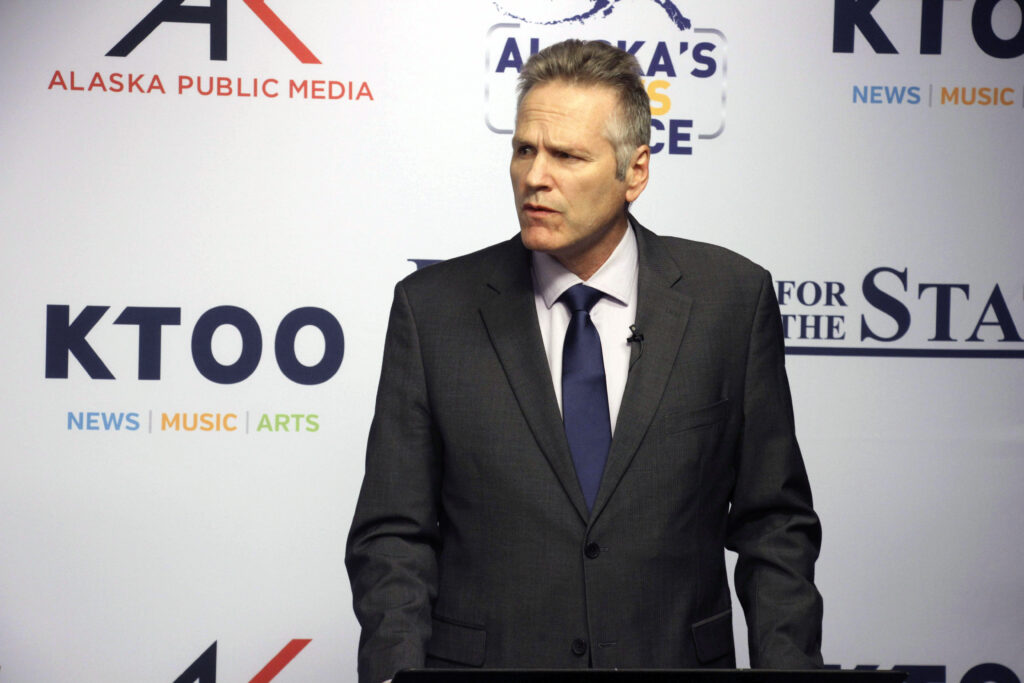GOP Gov. Mike Dunleavy has won reelection and will serve as Alaska governor for a second four-year term. Results of the November election were finalized Wednesday, with the Republican incumbent earning just over half of first-choice votes. It was the only statewide race that did not necessitate a ranked-choice voting tabulation, because Dunleavy earned a majority of votes, with 266,472 ballots counted. The Associated Press has the story:
Mike Dunleavy is 1st Alaska Gov. reelected since ’98
Newslooks- JUNEAU, Alaska (AP)
Alaska Republican Gov. Mike Dunleavy has won reelection, becoming the first governor in the state since 1998 to win back-to-back terms.
Dunleavy received over 50% of the vote after final tallies were released Wednesday, and the race did not go to ranked choice voting.
Dunleavy said he was “relieved that it’s over and behind us and now we can focus on the next four years.”
He attributed the victory to effective communication he says he had with Alaska residents, a practice that started with the COVID-19 pandemic.
“We told the people of Alaska on the first press conference we had on that virus that we were going to communicate consistently, constantly, and we were going to be transparent in everything we reported to the people, and that became the norm,” Dunleavy said in a phone interview after the win.
“I think that strengthened the relationship between myself and the people of Alaska,” he said.
![]()
Gov. Mike Dunleavy speaks to a reporter on election night in Anchorzge. His lieutenant governor running mate, Nancy Dahlstrom, is at left. (Anne Raup / ADN)
Dunleavy, who during his first term faced a recall effort, overcame challenges in the Nov. 8 election from former Gov. Bill Walker, an independent; Democrat Les Gara, a former state lawmaker; and Republican Charlie Pierce, a former borough mayor who rejected calls to suspend his campaign after he was sued in October by a woman who said he sexually harassed her.
Gara and his running mate, Jessica Cook, congratulated Dunleavy and Lt. Gov.-elect Nancy Dahlstrom.
“Both of us wish Mike and Nancy strength as they address daunting problems that face all of us, from struggling schools that impact student opportunity to silent but damaging crises, including the lack of affordable and accessible childcare, affordable housing, and a vastly inadequate mental health workforce that’s needed by children and adults living in crisis,” he said in a statement.
Dunleavy kept a low profile during the campaign, with Walker and Gara lamenting his decision to appear in just a handful of debates.
Dunleavy’s first term was marked early on by tensions with lawmakers in both parties and by a recall effort fueled by public anger over vetoes and budget cuts he had proposed. Recall backers abandoned their push last year, with the governor’s race looming.
Dunleavy touted as significant the dividend paid to residents this year from Alaska’s oil-wealth fund, which combined with a one-time energy relief payment of $662 totaled $3,284 per person. He said the money would provide relief to Alaskans amid high inflation and energy costs. Last year’s dividend was $1,114. There is a yearly application process and residency requirements to qualify for a dividend.

Walker said he thought the payout, approved by lawmakers earlier this year amid a spike in oil prices, benefited Dunleavy’s candidacy.
“It’s hard to argue with money being sent out,” he said in an interview after the election.
The amount available for dividends for years was determined by a formula. But Walker, while governor in 2016 and facing deficits, cut the amount of funds available for checks. The size since has been set by lawmakers, who have been using earnings from the oil-wealth fund, long used to pay dividends, to also help pay for government expenses and limiting what can be withdrawn each year from earnings.
Dunleavy for years pushed unsuccessfully for a dividend in line with the old formula. He later proposed dividing the annual withdrawal from earnings 50/50 between dividends and government expenses. This year’s dividend was in line with that approach.
Two public interest groups in September filed a complaint with the agency that enforces Alaska campaign finance rules, alleging improper coordination between Dunleavy’s campaign and a third-party group that supported Dunleavy’s reelection. The campaign denied any coordination. An investigation report was expected sometime after the election.
This year’s state elections were the first since a divided federal appeals court panel last year struck down certain contribution limits, including limits on what an individual can give to candidates.
Gara was especially critical of the decision and blamed the Dunleavy administration for not challenging the ruling. He said on social media that he would “be there to work on a voter initiative to put limits back on Alaska campaign donations, so your voices are not treated less importantly than the voices of outside donors.”
Dunleavy ran on a ticket with Dahlstrom, a former state lawmaker who led the state corrections department during much of Dunleavy’s first term. The lieutenant governor, among other responsibilities, oversees elections in Alaska.
Dunleavy’s new term begins the first Monday in December.







